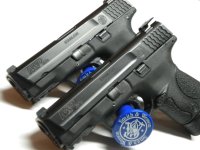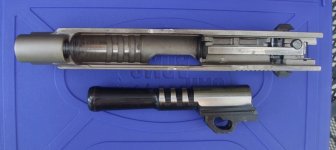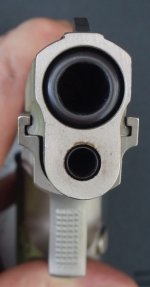Given my previous post, I am obviously a big .357 SIG fan, but the FBI and others aren't completely wrong about how a "heavier bullet traveling at higher velocity which hits harder, penetrates deeper, and expands to a larger diameter offers no real performance advantage."
Let's take the .44 Magnum for example. When a bullet is too heavy and/or too fast, it might tend to over penetrate (and thus spending its advantages). If you read or listen to what trauma room surgeons have to say about treating gunshot wounds, it's usually much worse for a patient if the bullet did not leave the body because often when it does much of its energy leaves along with it. As such there is literally a sweet spot in ballistics (actually, there is likely more than one in my opinion).
Many believe this sweet spot is monopolized by the ballistics of a good 9mm parabellum cartridge (or the equivalent loaded in a different round), but others are right in my opinion to identify another more powerful sweet spot created by the .357 SIG (i.e. over 500 ft. lbs. of energy that reliably penetrates between 12 and 18 inches, for example).
But getting back to my point, there is a good argument to be made by the FBI and others (however imperfect) that .40 S&W and .45 ACP offer no real strategic advantage for self defense; however, once you exceed the energy created by the majority of those rounds, there is at the very least a modest advantage, but only to a point (again, .44 Mag). Don't get me wrong, .44 Magnum is better for killing someone than calibers 9mm through .357 SIG, but it might not necessarily be as good at stopping an attacker. For example, in the study published by the Buckeye Firearms Association (
An Alternate Look at Handgun Stopping Power | Buckeye Firearms Association), .44 Magnum fails to incapacitate about 13% of the time (tied with 9mm & .40 S&W) while .357 SIG fails about 9% of the time (tied with centerfire rifles). As one trauma room mentioned, an attacker can survive up to 15 seconds—without a heart (which is practically a lifetime in a gunfight).
So I personally think .357 SIG offers an advantage even over .44 Magnum, but 10mm, on the other hand, is a little less certain in my opinion, not because I don't believe it
can be just as effective, if not more so (if that's possible), but I am not sure where to draw the line, ballistically speaking (again, if one exists) because I don't have any real world data. I only have less than perfect evidence that might suggest its superiority by way of ballistic gelatin tests whereas we have better real world data suggesting the advantages of .357 SIG (which already borders on over penetrating as it is). In other words, I trust the results of real gunfights much more than ballistic gel testing.
The truth is, however, that even .380 ACP can over penetrate though I don't know how much energy would be left that might be wasted (practically speaking). I really wish I had the means of easily conducting my own ballistic data testing (and evidence collecting) as I'd love to do so. It is almost certain 10mm offers a significant advantage dispatching bears with thick skulls, for example, but I don't have anything to point to regarding humans.
I agree with a whole lot of this. Here is an excerpt from an FBI document regarding some of the shortcomings of collected shooting incident data, that you may find interesting.
THE ALLURE OF SHOOTING INCIDENT ANALYSES
There is no valid, scientific analysis of actual shooting results in existence, or being pursued to
date. It is an unfortunate vacuum because a wealth of data exists, and new data is being sadly generated
every day. There are some well publicized, so called analyses of shooting incidents being promoted,
however, they are greatly flawed. Conclusions are reached based on samples so small that they are
meaningless. The author of one, for example, extols the virtues of his favorite cartridge because he has
collected ten cases of one shot stops with it.38 Preconceived notions are made the basic assumptions on
which shootings are categorized. Shooting incidents are selectively added to the "data base" with no
indication of how many may have been passed over or why. There is no correlation between hits, results,
and the location of the hits upon vital organs.
It would be interesting to trace a life-sized anatomical drawing on the back of a target, fire 20
rounds at the "center of mass" of the front, then count how many of these optimal, center of mass hits
actually struck the heart, aorta, vena cava, or liver.39 It is rapid hemorrhage from these organs that will
best increase the likelihood of incapacitation. Yet nowhere in the popular press extolling these studies of
real shootings are we told what the bullets hit.
These so called studies are further promoted as being somehow better and more valid than the
work being done by trained researchers, surgeons and forensic labs. They disparage laboratory stuff,
claiming that the "street" is the real laboratory and their collection of results from the street is the real
measure of caliber effectiveness, as interpreted by them, of course. Yet their data from the street is
collected haphazardly, lacking scientific method and controls, with no noticeable attempt to verify the less
than reliable accounts of the participants with actual investigative or forensic reports. Cases are
subjectively selected (how many are not included because they do not fit the assumptions made?). The
numbers of cases cited are statistically meaningless, and the underlying assumptions upon which the
collection of information and its interpretation are based are themselves based on myths such as knock-
down power, energy transfer, hydrostatic shock, or the temporary cavity methodology of flawed work
such as RII.
Further, it appears that many people are predisposed to fall down when shot. This phenomenon is
independent of caliber, bullet, or hit location, and is beyond the control of the shooter. It can only be
proven in the act, not predicted. It requires only two factors to be effected: a shot and cognition of being
shot by the target. Lacking either one, people are not at all predisposed to fall down and don't. Given this
predisposition, the choice of caliber and bullet is essentially irrelevant. People largely fall down when
shot, and the apparent predisposition to do so exists with equal force among the good guys as among the
bad. The causative factors are most likely psychological in origin. Thousands of books, movies and
television shows have educated the general population that when shot, one is supposed to fall down.
38 He defines a one shot stop as one in which the subject dropped, gave up, or did not run more than 10 feet. 39 This exercise was suggested by Dr. Martin L. Fackler, U.S. Army Wound Ballistics Laboratory, Letterman Army
Institute of Research, San Francisco, California, as a way to demonstrate the problematical results of even the
best results sought in training, i.e., shots to the center of mass of a target. It illustrates the very small actually
critical areas within the relatively vast mass of the human target
The problem, and the reason for seeking a better cartridge for incapacitation, is that individual
who is not predisposed to fall down. Or the one who is simply unaware of having been shot by virtue of
alcohol, adrenaline, narcotics, or the simple fact that in most cases of grievous injury the body suppresses
pain for a period of time. Lacking pain, there may be no physiological effect of being shot that can make
one aware of the wound. Thus the real problem: if such an individual is threatening one's life, how best to
compel him to stop by shooting him?
The factors governing incapacitation of the human target are many, and variable. The actual
destruction caused by any small arms projectile is too small in magnitude relative to the mass and
complexity of the target. If a bullet destroys about 2 ounces of tissue in its passage through the body, that
represents 0.07 of one percent of the mass of a 180 pound man. Unless the tissue destroyed is located
within the critical areas of the central nervous system, it is physiologically insufficient to force
incapacitation upon the unwilling target. It may certainly prove to be lethal, but a body count is no
evidence of incapacitation. Probably more people in this country have been killed by .22 rimfires than all
other calibers combined, which, based on body count, would compel the use of .22's for self-defense. The
more important question, which is sadly seldom asked, is what did the individual do when hit?
There is a problem in trying to assess calibers by small numbers of shootings. For example, as has
been done, if a number of shootings were collected in which only one hit was attained and the percentage
of one shot stops was then calculated, it would appear to be a valid system. However, if a large number of
people are predisposed to fall down, the actual caliber and bullet are irrelevant. What percentage of those
stops were thus preordained by the target? How many of those targets were not at all disposed to fall
down? How many multiple shot failures to stop occurred? What is the definition of a stop? What did the
successful bullets hit and what did the unsuccessful bullets hit? How many failures were in the vital
organs, and how many were not? How many of the successes? What is the number of the sample? How
were the cases collected? What verifications were made to validate the information? How can the
verifications be checked by independent investigation?
Because of the extreme number of variables within the human target, and within shooting
situations in general, even a hundred shootings is statistically insignificant. If anything can happen, then
anything will happen, and it is just as likely to occur in your ten shootings as in ten shootings spread over
a thousand incidents. Large sample populations are absolutely necessary.
Here is an example that illustrates how erroneous small samples can be. I flipped a penny 20
times. It came up heads five times. A nickel flipped 20 times showed heads 8 times. A dime came up
heads 10 times and a quarter 15 times. That means if heads is the desired result, a penny will give it to
you 25% of the time, and nickel 40% of the time, a dime 50% of the time and a quarter 75% of the time.
If you want heads, flip a quarter. If you want tails, flip a penny. But then I flipped the quarter another 20
times and it showed heads 9 times - 45% of the time. Now this "study" would tell you that perhaps a dime
was better for flipping heads. The whole thing is obviously wrong, but shows how small numbers lead to
statistical lies. We know the odds of getting a head or tail are 50%, and larger numbers tend to prove it.
Calculating the results for all 100 flips regardless of the coin used shows heads came up 48% of the time.
The greater the number and complexity of the variables, the greater the sample needed to give
meaningful information, and a coin toss has only one simple variable – it can land heads or it can land
tails. The coin population is not complicated by a predisposition to fall one way or the other, by chemical
stimuli, psychological factors, shot placement, bone or obstructive obstacles, etc.; all of which require
even larger numbers to evidence real differences in effects.
Although no cartridge is certain to work all the time, surely some will work more often than
others, and any edge is desirable in one's self defense. This is simple logic. The incidence of failure to
incapacitate will vary with the severity of the wound inflicted.40 It is safe to assume that if a target is
always 100% destroyed, then incapacitation will also occur 100% of the time. If 50% of the target is
destroyed, incapacitation will occur less reliably. Failure to incapacitate is rare in such a case, but it can
happen, and in fact has happened on the battlefield. Incapacitation is still less rare if 25% of the target is
destroyed. Now the magnitude of bullet destruction is far less (less than 1% of the target) but the
relationship is unavoidable. The round which destroys 0.07% of the target will incapacitate more often
than the one which destroys 0.04%. However, only very large numbers of shooting incidents will prove it.
The difference may be only 10 out of a thousand, but that difference is an edge, and that edge should be
on the officer's side because one of those ten may be the subject trying to kill him.
To judge a caliber's effectiveness, consider how many people hit with it failed to fall down and
look at where they were hit. Of the successes and failures, analyze how many were hit in vital organs,
rather than how many were killed or not, and correlate that with an account of exactly what they did when
they were hit. Did they fall down, or did they run, fight, shoot, hide, crawl, stare, shrug, give up and
surrender? ONLY falling down is good. All other reactions are failures to incapacitate, evidencing the
ability to act with volition, and thus able to choose to continue to try to inflict harm.
Those who disparage science and laboratory methods are either too short sighted or too bound by
preconceived (or perhaps proprietary) notions to see the truth. The labs and scientists do not offer sure
things. They offer a means of indexing the damage done by a bullet, understanding of the mechanics of
damage caused by bullets and the actual effects on the body, and the basis for making an informed choice
based on objective criteria and significant statistics.
The differences between bullets may be small, but science can give us the means of identifying
that difference. The result is the edge all of law enforcement should be looking for. It is true that the
streets are the proving ground, but give me an idea of what you want to prove and I will give you ten
shootings from the street to prove it. That is both easy, and irrelevant. If it can happen, it will happen.
Any shooting incident is a unique event, unconstrained by any natural law or physical order to
follow a predetermined sequence of events or end in predetermined results. What is needed is an edge that
makes the good result more probable than the bad. Science will quantify the information needed to make
the choice to gain that edge. Large numbers (thousands or more) from the street will provide the answer
to the question "How much of an edge?".41 Even if that edge is only 1%, it is not insignificant because
the guy trying to kill you could be in that 1%, and you won't know it until it is too late.



